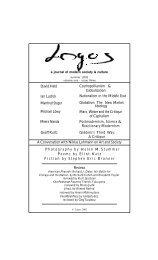Michael J. Thompson Stephen Eric Bronner Wadood Hamad - Logos
Michael J. Thompson Stephen Eric Bronner Wadood Hamad - Logos
Michael J. Thompson Stephen Eric Bronner Wadood Hamad - Logos
Create successful ePaper yourself
Turn your PDF publications into a flip-book with our unique Google optimized e-Paper software.
Ali Hossaini<br />
The transformation accelerated when the sciences of Mesopotamia and Egypt<br />
passed into Greece. A critical attitude evolved within Greek science, perhaps<br />
because thinkers tried to reconcile alternative systems. By the sixth century<br />
BCE, Greek artists began to display a concern with realism, and we see the<br />
beginning of furious philosophic debates over proper representation.<br />
Investigations into visual truth began emanating from workshops and<br />
academies, and over centuries painters adapted the techniques of perspective,<br />
laying the foundation for optical science. Greek investigations into scientific<br />
representation culminated in Euclid’s Geometry and Optics, which were<br />
completed in the third century BCE.<br />
Among their many accomplishments, Euclid’s mathematical studies reconcile<br />
the dualism that plagued Platonic philosophy. Plato denigrated perception<br />
because the shifting appearances of things contradicted what we know. In<br />
mathematical terms, geometry describes what we know, and optics describes<br />
how we see. By deriving optics from geometry, Euclid demonstrated the<br />
validity of visual information. Vision distorts geometric space—it distorts<br />
reality—but it does so systematically. As any surveyor knows, by accounting<br />
for the effects of perspective, we can glean accurate data about visual objects.<br />
The obvious solution to Plato’s dilemma is to systematically relate optical<br />
“slices,” individual perspectives, to a coordinated, geometric whole.<br />
Thinkers from Claudius Ptolemy 10 to Rudolph Arnheim 11 have proposed<br />
something like Euclid’s schema, and <strong>Stephen</strong> Kosslyn’s work Image and Brain<br />
extends that work to the imagination. When we remember a visual image,<br />
the visual cortex hosts an event physiologically similar to actual perception.<br />
We may recall James Gibson’s arguments against mental imagery, but<br />
Kosslyn presents convincing experimental evidence for pictorialism and the<br />
matter should be closed. 12 However, we can still query the human visual<br />
system, questioning why it evolved as it did. Could we have evolved a<br />
“sightless vision,” the cybernetic vision Paul Virilio describes in The Vision<br />
Machine? We sometimes perceive without sensation, as when we<br />
automatically block a stray ball. There are alternative forms of visual<br />
perception that do not rely in internal representation, for instance, in<br />
computers that use neural nets for navigation. The human brain is often<br />
described as a neural net. Could consciousness have evolved differently?<br />
What role does preconscious processing play in our responses? How does<br />
vision relate to faculties like language?<br />
<strong>Logos</strong> 2.3 – Summer 2003




